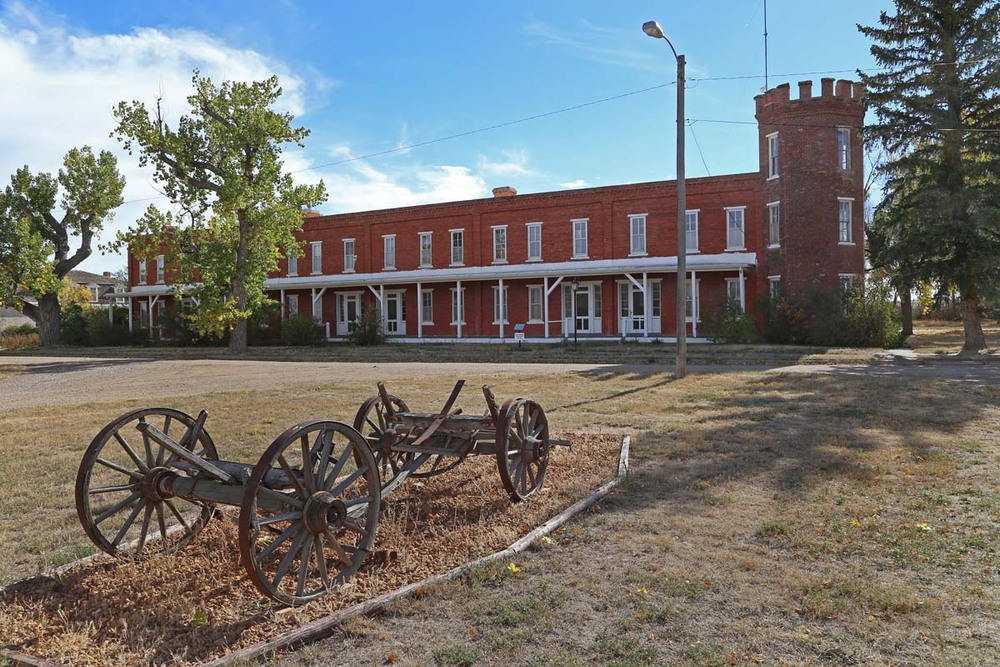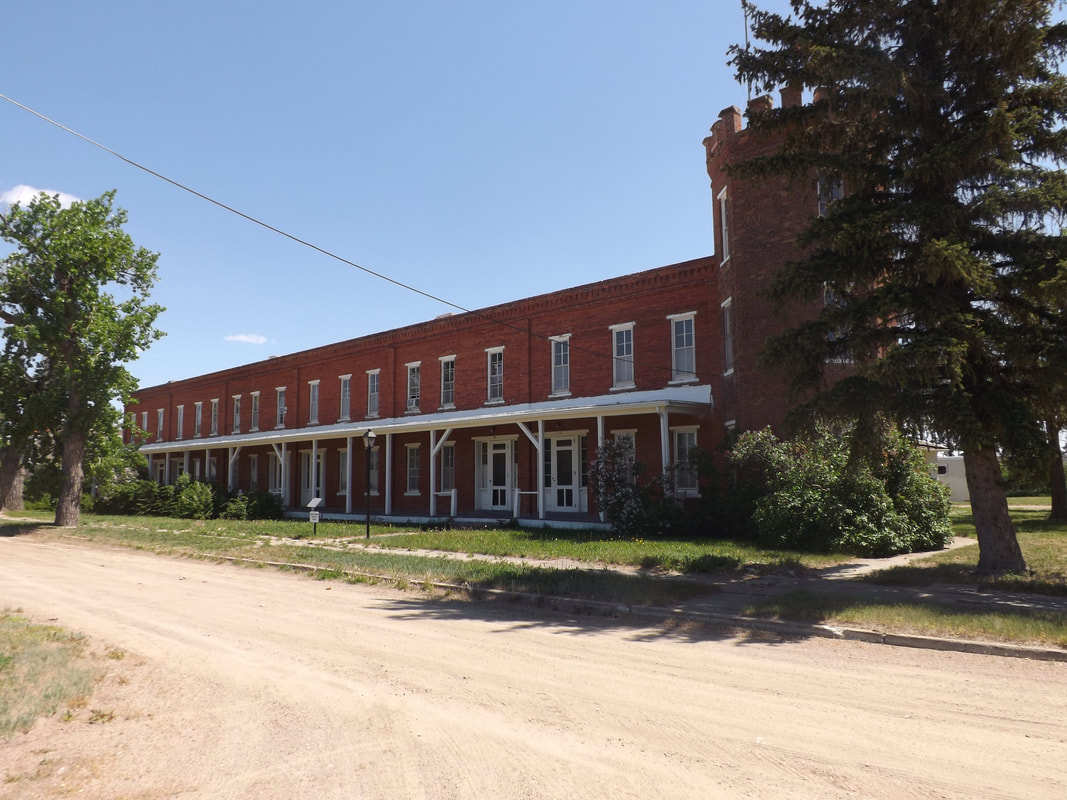
The Ghost of Grandeur: Fort Assinniboine, Montana’s Forgotten Frontier Jewel
On the vast, windswept plains of north-central Montana, where the sky stretches endlessly and the Milk River carves its ancient path, lie the sparse, weathered remnants of what was once an ambitious monument to American expansion and military might. Fort Assinniboine, established in 1879, was not just another frontier outpost; it was envisioned as the "showplace of the plains," a beacon of order and a formidable bulwark against perceived threats from both indigenous peoples and the nascent Canadian presence to the north. Today, its grand vision is largely reduced to scattered brick foundations and a few enduring structures, yet the story of Fort Assinniboine offers a compelling glimpse into a pivotal, often romanticized, era of American history.
The genesis of Fort Assinniboine lay in the tumultuous aftermath of the Indian Wars and a shifting strategic landscape. Following the Battle of the Little Bighorn in 1876, the U.S. Army intensified its efforts to control the remaining free-roaming tribes and secure the frontier. Concurrently, the burgeoning Canadian West, particularly the North-West Mounted Police (NWMP) presence and the potential for Métis unrest, created a need for a strong military presence near the international border. The chosen site, near the confluence of Beaver Creek and the Milk River, offered strategic advantages: access to water, grazing land, and a position roughly equidistant from tribal lands to the south and the Canadian border to the north.
More than just a military outpost, Fort Assinniboine was an audacious statement. Unlike the often hastily constructed log and sod forts that characterized earlier frontier expansion, Assinniboine was built to last, a testament to permanence and federal investment. Its construction, initiated in 1879, was a monumental undertaking, costing over a million dollars in 1880s currency – an astronomical sum for the time. This massive investment translated into a fort of unparalleled scale and sophistication for the frontier.

A Marvel of Frontier Engineering
"It was designed not merely as a defensive position, but as a model of military efficiency and a comfortable home for its soldiers," noted historian Dr. Eleanor Vance, specializing in frontier architecture. "The Army’s intent was clear: this was to be the finest post in the West, a symbol of their commitment to securing the northern plains."
The fort boasted over 100 buildings, meticulously constructed from locally manufactured brick. These weren’t crude, temporary structures; they included expansive two-story barracks for enlisted men, elegant officers’ quarters with multiple rooms, a state-of-the-art hospital, a post exchange, a guardhouse, stables, workshops, and even a spacious post headquarters. A central parade ground, meticulously graded, formed the heart of the complex.
Perhaps the most impressive aspect of Assinniboine’s design was its advanced infrastructure. Unlike many posts that relied on hand-dug wells or nearby streams, Fort Assinniboine featured an elaborate water system. Water was pumped from the Milk River into a large reservoir, then distributed throughout the fort via underground pipes, providing running water to many of the buildings – a luxury almost unheard of on the frontier. A sophisticated sewer system further enhanced sanitation, contributing to a significantly lower rate of disease compared to other, less developed posts. The fort was also equipped with its own brickyard and sawmill, allowing for self-sufficiency in construction and repairs.
Life at Fort Assinniboine, despite its amenities, was far from a picnic. The Montana climate was brutal, with scorching summers and notoriously frigid winters where temperatures could plummet to fifty degrees below zero. Isolation was a constant companion. The nearest major settlement, Fort Benton, was over 70 miles away, a journey that could take days by wagon. Mail delivery was infrequent, and the arrival of supplies or news from the outside world was a significant event.
A Soldier’s Life on the Plains
For the soldiers stationed there, routine was the bedrock of existence. Drills, inspections, guard duty, and the endless maintenance of the fort filled their days. Patrols across the vast, empty landscape were frequent, aimed at monitoring tribal movements, deterring whiskey traders, and asserting federal authority. Despite the strategic importance of the fort, major engagements were rare. Its very presence served as a deterrent.
Yet, life was not without its moments of drama. The fort played a crucial role during the North-West Rebellion (also known as the Riel Rebellion) in Canada in 1885. As Métis and First Nations forces clashed with Canadian troops, American authorities feared the conflict might spill over the border. Fort Assinniboine became a staging ground for U.S. troops, who patrolled the border with heightened vigilance to prevent American citizens from joining the rebellion and to ensure that no hostile forces crossed into U.S. territory. This period highlighted the fort’s strategic significance, demonstrating its capacity to project power and maintain neutrality in a volatile region.

One soldier, Private Thomas O’Malley, writing home in 1888, captured the essence of life there: "The fort itself is grand, a veritable city compared to the dust-traps I’ve known. But the land… the land is endless. You can ride for days and see naught but grass and sky. The winters bite with a ferocity that chills the very bone, and in summer, the heat can make a man’s brain boil. We are here, a small island of brick and order, in a sea of magnificent, indifferent wilderness. Our purpose, I suppose, is to remind that wilderness who is ultimately in charge, though sometimes, I wonder if it truly listens."
Beyond its military functions, Fort Assinniboine fostered a small but vibrant community. Families of officers and some enlisted men created a semblance of domestic life. A schoolhouse educated the children, and social events, though infrequent, provided much-needed diversion. The fort also became a point of interaction, sometimes tense, sometimes cooperative, with various indigenous groups, including the Assiniboine, Gros Ventre, and Blackfeet, whose traditional lands encompassed the area. The fort’s presence gradually altered the economic and social fabric of the region, drawing in traders, ranchers, and homesteaders who saw the military presence as a guarantee of safety.
The Inevitable Decline
But even the grandest forts are not immune to the relentless march of time and the shifting sands of national priorities. By the turn of the 20th century, the American frontier was largely considered "closed." The Indian Wars were over, and the threat of large-scale tribal uprisings had diminished. The border with Canada was peaceful, secured by diplomacy and the mutual respect between two developing nations. New military technologies, particularly rapid transportation via railroads and more advanced weaponry, rendered fixed, large-scale forts like Assinniboine increasingly obsolete.
The grand vision that had birthed Fort Assinniboine began to fade. The need for such a massive, well-appointed post diminished with each passing year. The Army’s focus shifted towards coastal defenses, overseas expeditions, and the development of a modern, mobile fighting force. Maintenance on the sprawling complex became a burden, and the remote location, once a strategic advantage, was now a logistical inconvenience.
The final chapter for Fort Assinniboine began with a whimper, not a bang. In 1911, just 32 years after its ambitious inception, the fort was officially decommissioned. The decision sparked a flurry of activity as local settlers and entrepreneurs descended upon the site, eager to salvage its valuable materials. An auction was held, and the fort, once a symbol of federal power, was systematically dismantled. Brick by brick, timber by timber, the buildings were scavenged. Many of the distinctive red bricks found their way into new homes, schools, and businesses in nearby Havre and other burgeoning Montana towns, their deep red hue a constant, silent reminder of the fort’s former glory. Window frames, doors, plumbing fixtures, and anything of value were stripped away, leaving behind only the most stubborn foundations and the ghost of its former self.
A Legacy in the Soil
Today, where grand barracks once stood and bugle calls echoed across the parade ground, the Montana State University’s Northern Agricultural Research Center now operates. The land, once dedicated to military might, is now devoted to scientific inquiry and the improvement of agriculture in the arid northern plains. A few of the original brick buildings, repurposed and renovated, still stand, offering a tangible link to the past. The commanding officer’s quarters, the hospital, and a few other structures survive, their sturdy brick walls bearing witness to the passage of over a century.
But for the most part, Fort Assinniboine exists as an archaeological landscape, a collection of depressions, scattered bricks, and the faint outlines of roads and foundations that hint at the vastness of the original complex. Interpretive signs offer visitors a chance to imagine the bustling life that once filled these silent spaces. The wind, which once carried the sounds of reveille and drill commands, now whispers through the tall grasses, carrying echoes of a forgotten era.
Fort Assinniboine stands as a poignant reminder of America’s complex frontier history – a testament to ambition, resourcefulness, and the transient nature of power. It represents the paradox of the frontier: a place of both immense struggle and grand aspirations, where magnificent structures were erected only to be reclaimed by the very wilderness they sought to tame. Its story is not just about a fort, but about the closing of a chapter in American history, the end of the "wild West," and the enduring legacy of human endeavor etched into the rugged landscape of Montana. The ghost of its grandeur may linger, but its lessons about foresight, impermanence, and adaptation remain as vivid as the vast Montana sky.


